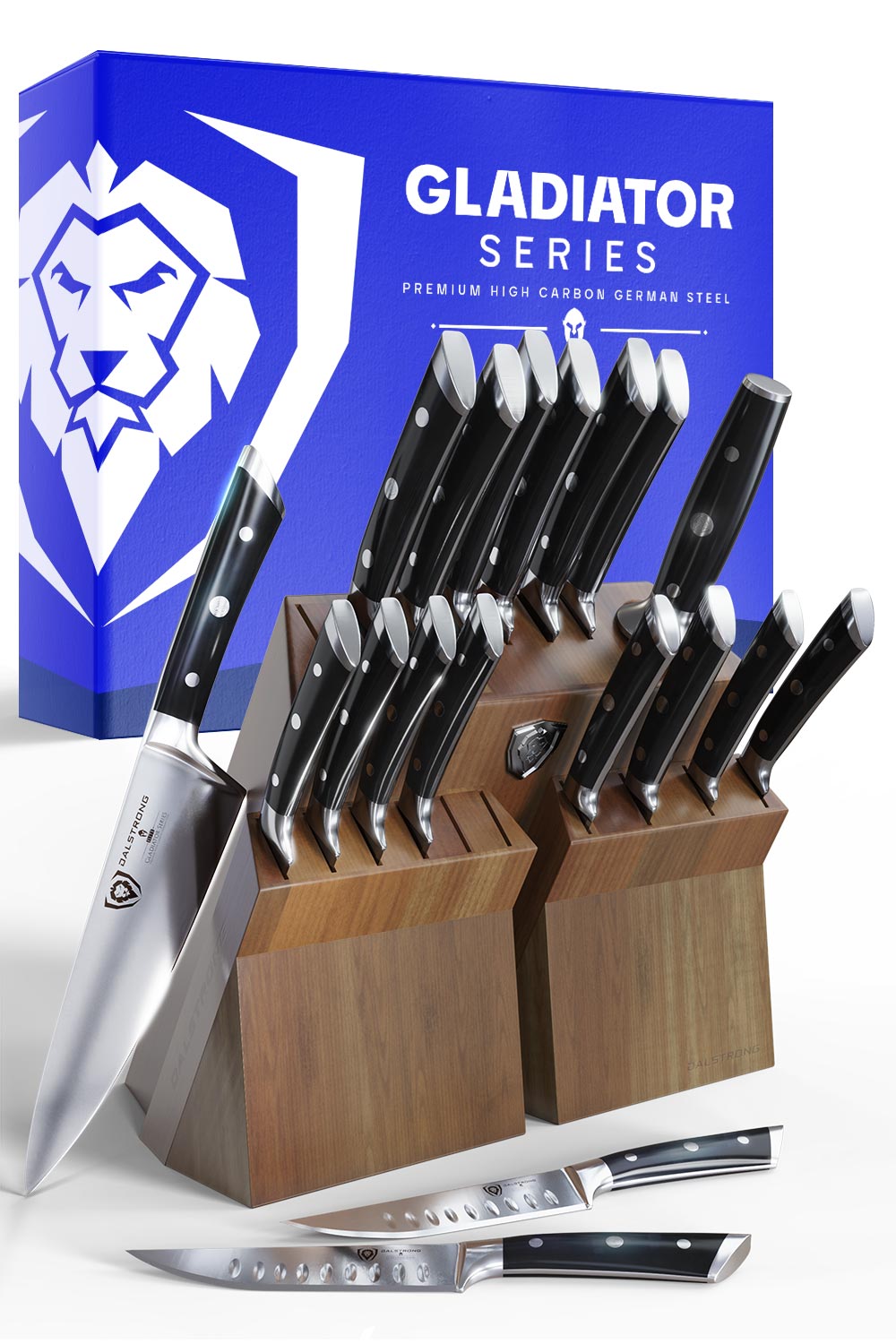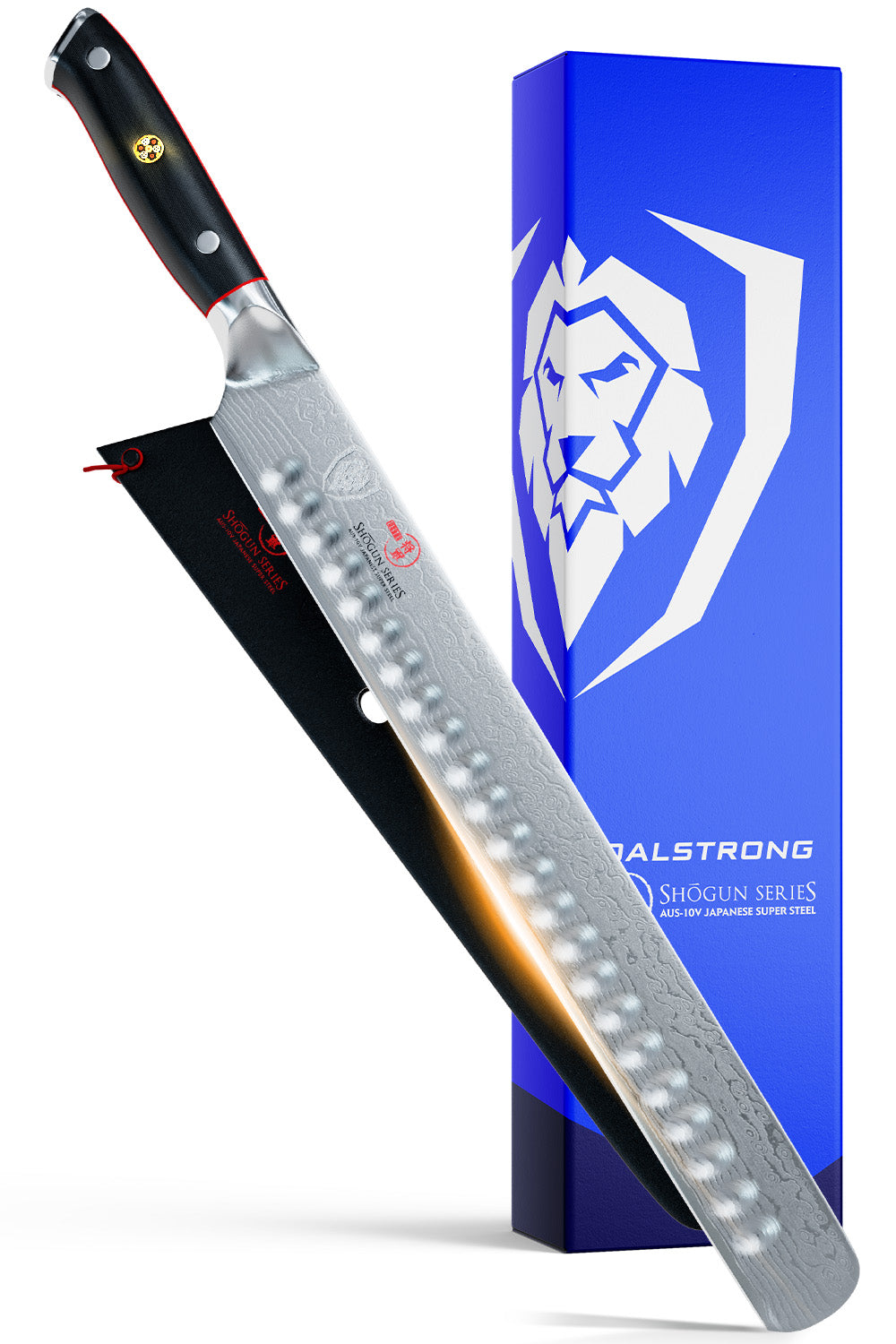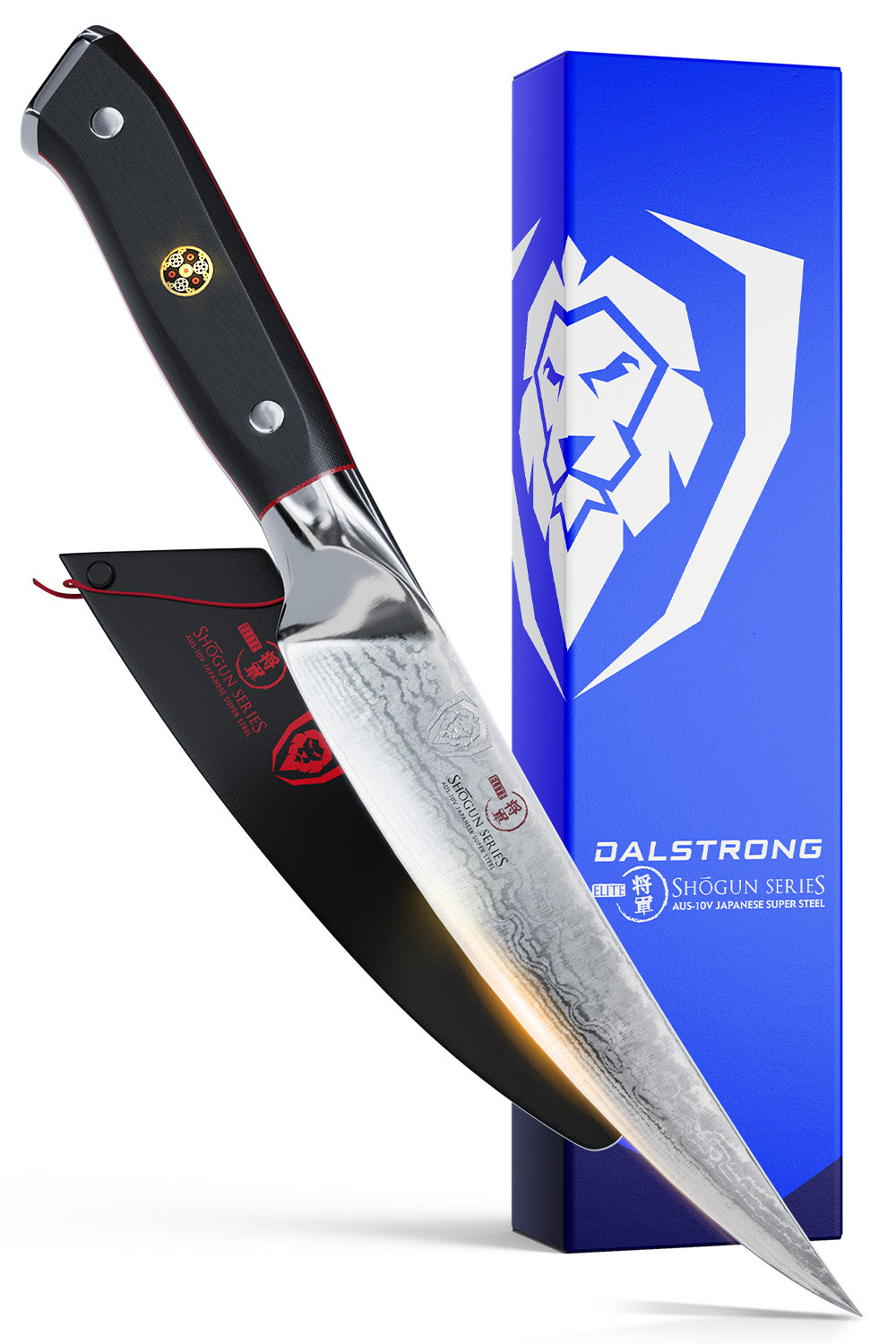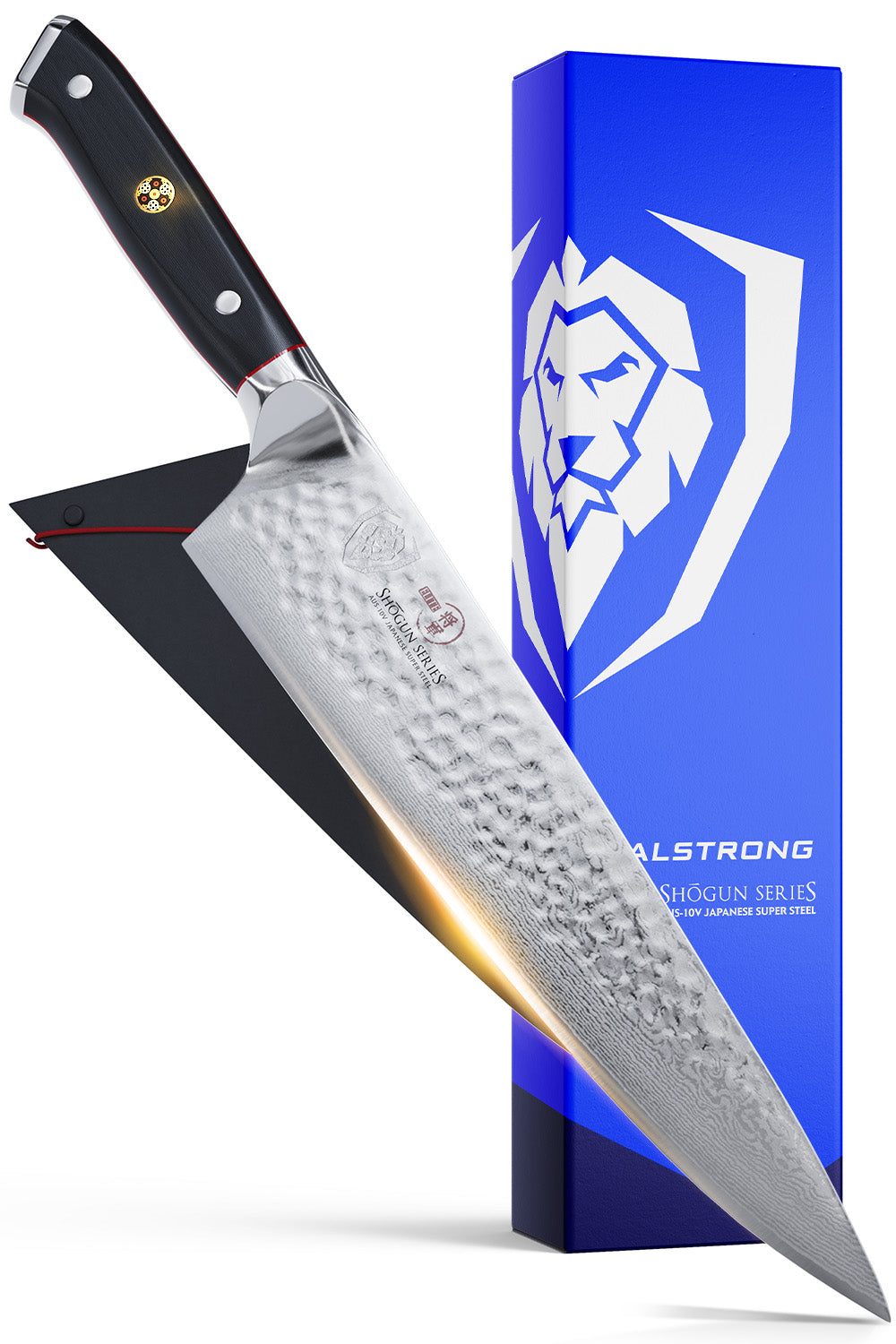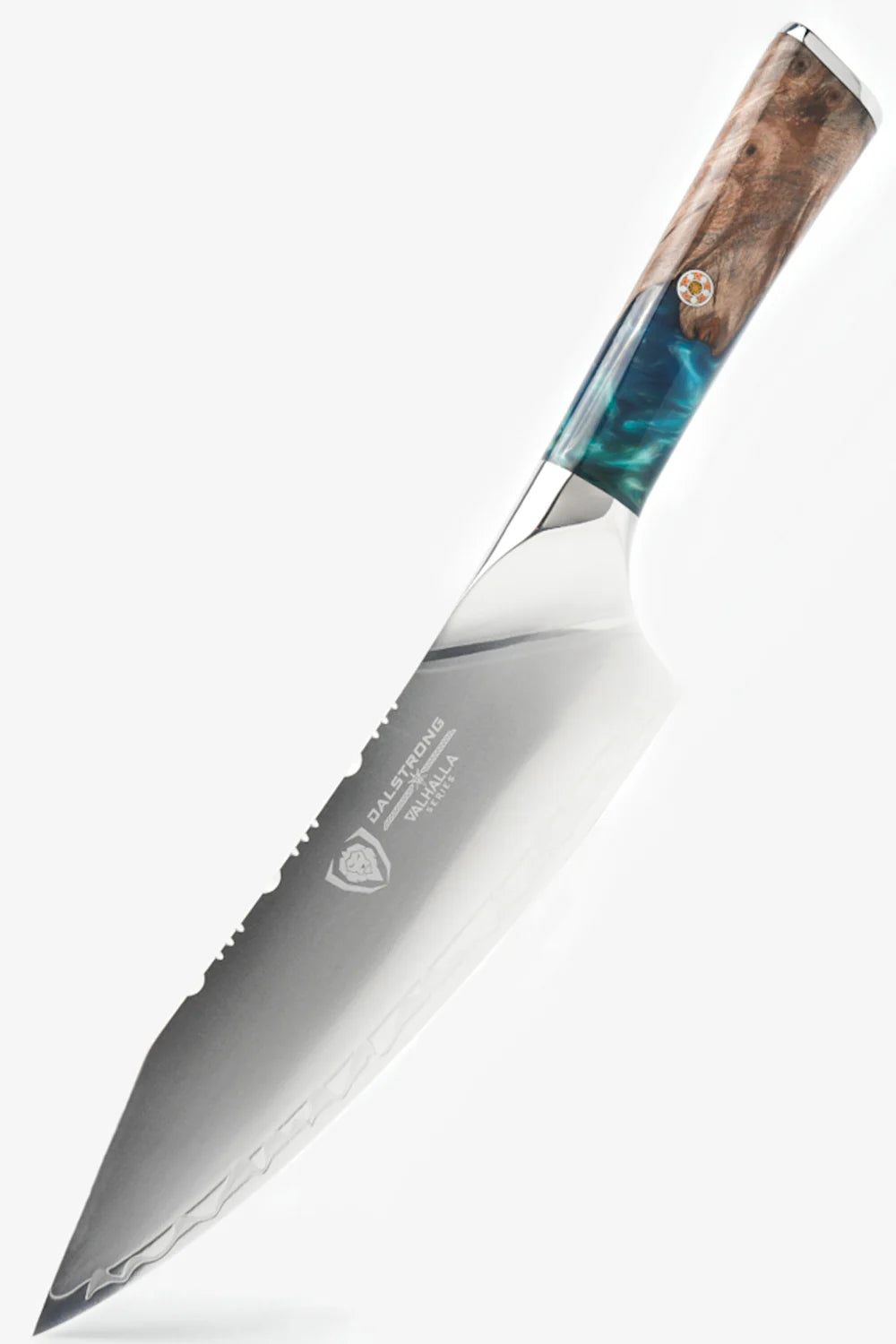12'' Slicing &Carving Knife | Shogun Series | Dalstrong ©
How To Cut A Watermelon
- Rinse and pat dry the watermelon.
- Slice the watermelon in half crosswise, then cut off the stem end.
- Hold your knife at an angle and cut down towards the cutting board.
- Slice the circular watermelon pieces into watermelon sticks.
- Slice the watermelon sticks into watermelon cubes.
Content Table :
- Let’s Talk About Watermelon
- How To Pick The Perfect Watermelon
- How To Cut A Watermelon
- Best Knives For Cutting Watermelons
- Top Ten Little-Known Facts About Watermelons
- Frequently Asked Questions
1. Let’s Talk About Watermelon

Watermelon is amazing. Not only is it a genuinely delicious fruit, it’s also one of the most refreshing things you can eat on a hot summer day like the fourth of July. Few things are as nice as hanging out with friends outside while you share some succulent pieces of watermelon. Even sharing cocktails made with watermelon juice is a great summer activity.
Speaking from personal experience, I never really gave much thought to how to cut a watermelon. To me it was pretty straightforward -- you hacked away at it with a knife and ate the pieces that resulted from that. Of course, this haphazard approach will inevitably produce a bunch of oddly-shaped, often structurally unsound pieces of fruit that won’t make for the best eating experience.
Let’s instead honor this incredible summer fruit, and all the good it provides to us, by making sure we’re cutting it into practical, easy-to-consume shapes that will maximize the enjoyment we get out of it. That’s ultimately what cooking is all about, right? Finding ways to enhance memories and make things more enjoyable for yourself and others.
So let’s talk about how to cut watermelon, for your watermelon recipes such as watermelon salad.
2. How To Pick A Perfect Watermelon
8.5'' Kiritsuke Chef's Knife | Omega Series | Dalstrong ©
Of course, as with just about any type of produce, half of the secret is making sure you pick a really good one at the supermarket or greengrocer. Before we cut the watermelon, we must pick a suitable watermelon to cut!
And as much as we can lay out all the conditions and the variables you should take into consideration when picking a watermelon, this is going to be a skill you acquire gradually, as you learn to trust your senses and what they’re communicating to you.
Thankfully, as far as fruit goes, watermelon is not particularly challenging when it comes to spotting the difference between a good one and a bad one. Still, before you learn how to cut a watermelon, you must learn how to find a perfect one, so let’s talk about what you need to take into consideration.
The first factor you must take into consideration is ripeness. An under ripe watermelon lacks the refreshing sweetness we all love about watermelons in the first place, and an overripe watermelon has an unpleasant dry and mealy texture, so you’ll want to keep an eye out for these tell-tale signs:
- A ripe watermelon should make a hollow sound when you knock on it or tap on its rind.
- The bottom of the watermelon will have what is known as a “field spot.” When it is ripe, this spot will be yellow.
- The rind should not easily scratch or give way under light pressure.
Next, it’s important to assess the fruit’s quality. After all, it’s not just ripeness that’s going to determine the overall quality of your watermelon; you also don’t want a watermelon that’s in bad shape.
- Is the watermelon shiny? If so, that might mean that it’s overgrown. Ideally, you want a watermelon that is matte, not shiny.
- A heavy watermelon is a juicy watermelon. Pick up a few watermelons and test them out for heaviness. The ones that feel heaviest for their size are likely the real juicy ones.
- Keep an eye out for bumps or holes, which can signal issues with bugs or with watering.
3. How To Cut A Watermelon
8'' Chef's Knife | Shogun Series | Dalstrong ©
Unlike pineapples, watermelons don’t look particularly intimidating when it comes to cutting them. In fact, cutting a watermelon is extremely satisfying. Running a sharp chef’s knife through a watermelon is almost therapeutic, like squeezing an anti-stress ball. The great news is - other than basic safety, you don't need any crazy knife skills to pull this one off.
Still, if you want to end up with good watermelon slices, watermelon wedges, watermelon triangles, watermelon sticks, or if you prefer to cut watermelon into cubes, you should take care to use the correct cutting technique.
Here’s our take on how to cut a watermelon. Remember, though, that watermelon can be enjoyed a number of different ways, including as slices with the rind on (where you’d be using the rind as a sort of handle!). Below we outline how to cut a watermelon into watermelon sticks or slice the watermelon into cubes, which I believe is the easiest way to cut the melon.
Kitchen tips : All you need a cutting board and a sharp knife...and a watermelon.
Step 1: Rinse and then pat dry the entire watermelon.
Step 2: Slice the watermelon in half crosswise with a sharp chef’s knife, resulting in two circular pieces.
Step 3: Cut off the stem end of the melon.
Step 4: Put the watermelon cut side down on a cutting board.
Step 5: Hold your knife at an angle and cut down towards the cutting board to remove the rind and the white melon flesh.
Step 6: Continue to cut like this until you’ve removed the entire melon rind.
Step 7: Slice the cut watermelon circles into sticks. If you’re looking to make watermelon sticks, you’re done!
Step 8: Use the sharp knife to slice the melon sticks into cubes.
Step 9: Repeat with the other melon pieces and with the other cut watermelon half, making them cubes of the same size.
Step 10: Chill the cut watermelon cubes in the refrigerator. Now you have perfectly cubed watermelon for your fruit salad or other method of consumption. You could also put the cubes in an airtight container and freeze for up to six months. Enjoy!
4. Best Knives For Cutting Watermelon
Now you know how to cut a watermelon, so your next step is to pick up the appropriate tool for the job. Remember, cutting a watermelon is already easy and fun, so you need a knife that will maximize the experience and make it as effortless as possible. So pick up a cutting board and one of these excellent knives.
1. Chef's Knife 8" | Phantom Series | Dalstrong ©
This powerful 8-inch chef’s knife from Dalstrong’s Phantom Series is not only a fantastic tool to cut watermelon, it’s also perhaps the only kitchen knife you really need.
PROS:
- This is a precision-forged 8” blade with premium Japanese AUS-8 steel.
- Features rock-hollow divots to minimize friction and stuck on your food, as well as a curved blade to easily guide it through a cut.
- Extremely sharp blade, hand-finished to a mirror polish within 13-15 degrees.
- Premium quality laminated Spanish pakkawood handles, giving the knife an elegant look.
CONS:
- The bevel is a bit shorter than a Yanagiba knife.
- It’s a bit on the lighter side for a chef’s knife.
2. Slicing & Carving Knife 12" | Delta Wolf Series | Dalstrong ©
This absolutely gorgeous slicing & carving knife is a visually impressive, imposing piece of kitchen hardware. Not only will it sail through any slicing and carving culinary challenge, it will also likely strike up a conversation with anyone who sees it in your arsenal.
PROS:
- 12” precision forged, ultra-sharp, wear-resistant, high-carbon steel at 60° Rockwell Hardness, for an easy and effortless cut.
- Black, non-reflective titanium-nitride coating adds corrosion resistance and non-stick properties, not to mention how incredibly cool it looks.
- A stylish and durable G10 camouflage handle.
- Granton style edge to reduce drag and friction, so even if you lack knife skills this blade will make slicing a watermelon easy as pie
CONS:
- At 12 inches, this is the largest knife in this list; might be too big for some home cooks.
- If you prefer a knife with more “bite,” maybe try a serrated knife instead of one with a Granton edge.
3. Slicing & Carving Knife 10" | Gladiator Series | NSF Certified | Dalstrong ©
Here’s a smaller alternative if you’re looking for a slicing and carving knife that still packs a wallop when it comes to performance and value. This is a great tool to use on melons.
PROS:
- Made of wear resistant, single-piece, high carbon German ThyssenKrupp Steel.
- Extremely durable premium ABS polymer handle, highly impervious to heat, cold, and moisture.
- B08C24YNZH: National Sanitation Foundation (NSF) Certified.
- Hand sharpened to 16-18° per side for the perfect balance between blade sharpness and resilience.
CONS:
- This knife does have a bit of flex, which makes it perfect to cut watermelon with but might have a hard time with tough cuts of meat.
- If you want a slicing and carving knife that’s a little bigger, check out the knife in the Delta Wolf series listed above.
4. Paring Knife 4" | Quantum 1 Series | Dalstrong ©
A paring knife is a great choice for performing a finer cut on smaller pieces of watermelon, and this is an absolutely stunning piece from Dalstrong’s Quantum 1 Series. Great for watermelon cubes.
PROS:
- The blade is made of ultra sharp, wear resistant, high carbon American BD1N-VX steel at 63+ HRC.
- Features the unique and visually dazzling Nova Prime blade pattern.
- Fiber-resin military grade G10 & carbon fibre hybrid handle; feels great to hold.
- An incredible gift for the knife lover in your family.
CONS:
- Its sleek look and unique handle design may not be everybody’s cup of tea.
- Of course, it is a paring knife, so keep that in mind when you’re considering purchasing this; it’s not a large all-purpose chef knife.
5. Produce Knife 6" | Gladiator Series | NSF Certified | Dalstrong ©
Here’s a powerful 6-inch knife specifically built to cut produce. It will help you slice, dice, chop, core, and peel fruits and vegetables with little effort. Be it melon, mango, or carrots, this is a great go-to for anything organic and tasty.
PROS:
- A powerful blade made of precision forged, ultra sharp, high carbon German steel.
- Features a unique design, with a flat profile and a blunt front specifically engineered to cut produce.
- A clean, understated design.
- Features a laminated, ergonomic G10 Garolite handle that is comfortable and easy to use..
CONS:
- This knife works great on produce, but you might find it challenging to apply it to some tougher foods.
- If you’re looking for something a bit more “all-purpose,” maybe look into getting a chef knife instead.
5. Top Little-Known Facts About Watermelon
- Watermelons are considered to be both a fruit and a vegetable! Like most fruits, it is sweet, originates from flowers that have been pollinated by bees, and contains seeds. But they also grow alongside summer vegetables like peas and corn, and are part of the botanical family of gourds (which contains vegetables such as cucumber and pumpkins). And yes, they are a melon.
- Watermelons are 92% water. This is what makes them so refreshing and juicy. It is also why they are known as “water” melons. That last part is just conjecture.
- Did you know there’s a National Day devoted to watermelon? That’s August 3rd, National Watermelon Day. There’s also a National Watermelon Month, which is July. It's a little weird that National Watermelon Day doesn’t take place during National Watermelon Month, but I’ve learned to accept that there are things outside my control.
- There are farmers in Japan who have been growing cube-shaped melons for decades now, cultivating them in box-like braces to make them grow into a square shape. This was originally done to allow them to fit better into standard refrigerators, and has now expanded into growing them in strange and unusual shapes such as hearts, pyramids, and my mother in law’s face.
- There’s an enduring myth about how consuming watermelon seeds will cause a watermelon to grow in your belly. This is in fact not true, as I’ve tried unsuccessfully for decades. But the seeds are actually quite nutritious, containing high levels of magnesium, zinc and protein.
- In 2019 English pop star Harry Styles released a song titled “Watermelon Sugar,” which, despite repeating the refrain “watermelon sugar” in its chorus, appears to actually be more about strawberries? It’s a very confusing creative choice.
- Americans eat more watermelons by weight than any other fruit.
- Speaking of weight, the Guinness Book of World Records recognized Christopher Kent of Sevierville, Tennessee as having grown the world’s heaviest watermelon, weighing 350.5 pounds. To give you some perspective, that’s about the weight of a French door refrigerator, a baby elephant, or The Mountain from Game of Thrones.
- There are watermelon seed spitting competitions, and Jason Schayot holds the record of 75 feet and 2 inches.
- You can eat the entire fruit! The delicious pink watermelon flesh is most people’s focus, but watermelon rinds are also tasty and nutritious, appearing stir-fried or stewed in many Chinese dishes.
6. Frequently Asked Questions About Watermelons
10'' Chef's Knife | Gladiator Series | Dalstrong ©
Is it better to cut watermelon cold or warm?
A cold watermelon is more likely to stay intact than a room temperature one.
How long after you buy a watermelon should you cut it?
If your watermelon is ripe (take a look at the How to Pick the Perfect Watermelon section of this article for more details) you can cut it right away, but be careful; once you cut your watermelon, you’ll need to eat it within a day or keep it in the refrigerator for 3 to 5 days in a large bowl covered in plastic wrap.
Should I get a watermelon slicer?
Like a lot of kitchen gadgets for hyper-specific purposes, you won’t get a lot of use out of one. A sharp chef knife is really all you need to cut watermelon. And sure, you could get a melon baller to make perfectly shaped melon balls, but what else are you going to use it for?
When are watermelons in season?
Watermelons are in season from July through August, and it takes 80 to 95 days for watermelons to become full-grown.
Can I freeze watermelon?
Sure, you can store watermelon in the freezer. Frozen watermelon makes a great treat. Cut it up and put it in an airtight container in the freezer for up to 6 months. You could also use this to make a delicious watermelon smoothie.
Are watermelon rinds edible?
Yep! And the watermelon rind is actually very nutritious as well. You could cut up a piece of rind and try some, or you could cook the rind. You could even pickle it!
How nutritious are watermelons?
They’re very nutritious. One cup of watermelon only contains about 46 calories, 12 grams of carbohydrates, 865 international units of vitamin A, 12 milligrams of vitamin C, 170 milligrams of potassium, not to mention zero fat, cholesterol, or sodium.
Do you need to eat watermelon cold?
To me, that's how it should be eaten. However, these days there are watermelon recipes that include an instant pot or an air fryer.
Written by Jorge FarahBorn on the coast of Colombia and based in Buenos Aires, Jorge is a cooking enthusiast and kitchenware obsessive with a tremendous amount of opinions.































































